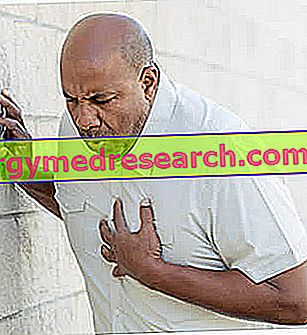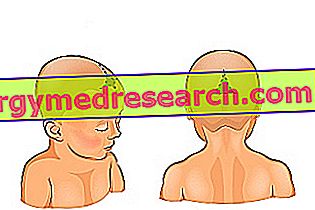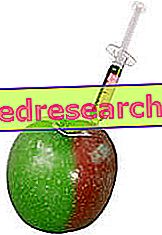Generality
Chest pain is a common clinical manifestation of many morbid conditions, some of which are also very serious.

The conditions that can cause chest pain include: heart diseases, lung diseases, problems with gastroesophageal site, episodes of pancreatitis, problems with the gall bladder, rib fractures, costochondritis, Tietze's syndrome, the pectoral muscle injuries, intercostal muscle injuries and shingles infections.
The therapy varies depending on the triggering factors.
What is chest pain
Chest pain, or chest pain, is a characteristic symptom of many morbid conditions, some more serious than others.
The possible area of interest is very wide: in fact, it includes the entire anatomical area that goes from the base of the neck, on the front of the human body, to the upper part of the abdomen.
FEATURES
Depending on the causes, chest pain can be:
- Acute;
- Deaf;
- Burning;
- Similar to a stabbing;
- Pressing (or overwhelming), in the sense that the patient has the impression that something compresses his chest;
ORGANS AND OTHER ANATOMICAL BREAST STRUCTURES
Inside the chest reside various organs and anatomical structures.
In addition to the known heart and lungs, in fact, the chest includes: the esophagus, the first part of the aorta, the pulmonary arteries, the cavities, the gall bladder, a part of the stomach, the pancreas, most of the ribs, the sternum, the clavicles, the pectoral muscles, the intercostal muscles, the diaphragm and a wide nervous network (eg: intercostal nerves, etc.).
The readers should not forget the external anatomical aspect of the chest, which includes the breasts and, obviously, a layer of skin.
Causes
The causes of chest pain are numerous.
The most well-known and common triggers include:
- Heart diseases;
- Lung diseases;
- Problems with gastroesophageal site, ie at the level of the stomach and / or esophagus;
- Pancreatitis episodes;
- Gallbladder and biliary tract problems;
- Rib fractures, ie rib fractures;
- Injuries of the pectoral and / or intercostal muscles;
- Costochondritis and Tietze's syndrome;
- Shingles infections (or Saint Anthony's Fire);
- Mastitis episodes.
OTHER CAUSES
Particular causes of chest pain are panic attacks and anxiety .
These conditions do not reflect a malfunction or alteration of anatomical organs or structures in the chest, but are the consequence of psycho-emotional problems that for unknown reasons have repercussions with a painful sensation in the chest.
HEART DISEASES
When doctors talk about heart diseases, they refer to a wide variety of conditions, including:
- Coronary heart disease : are coronary artery diseases. The coronary (or more simply coronary) arteries are the blood vessels that supply the heart with oxygen and nourishment.
In the presence of a coronary artery disease, the coronaries have a more or less severe narrowing, which prevents the blood from flowing adequately. The impairment of blood flow within the coronary arteries leads to a reduced supply of oxygen and nutrients to the cardiac tissues, which are affected in functional terms and, in the worst cases, also undergo necrosis.
People with coronary heart disease are at high risk for heart attack or myocardial ischemia.
In medicine, chest pain resulting from coronary artery disease takes the specific name of angina pectoris .
In addition to the chest, angina pectoris can also affect the arms (usually the left one), the shoulders (usually the left one) and / or the mandible. It can appear or worsen in intensity during a physical activity or during stressful circumstances.
Other symptoms: profuse sweating, nausea, dyspnoea, weakness, etc.
- Myocarditis : is inflammation of the myocardium . The myocardium is the muscle of the heart, particular because it has the extraordinary ability to self-control.
Myocarditis can be caused by: viral or bacterial infections, some autoimmune diseases, exposure to heavy metals, alcohol abuse, some allergic reactions, etc.
Other symptoms: fever, fatigue, accelerated heart rate, breathing problems, etc.
- Pericarditis : is the inflammation of the pericardium. The pericardium is the membrane that wraps, supports and protects the heart.
Pericarditis episodes may occur due to: viral, bacterial or parasitic infections, endocarditis, pneumonia, thoracic trauma, autoimmune diseases, etc.
In general, the chest pain that characterizes pericarditis is an acute and constant sensation which, in some patients, tends to spread to the upper part of the neck and to the shoulder muscles.
It is rare (but possible) for the pain sensation to become more intense, during deep breaths, during swallowing of food and in a lying position on the back.
Other symptoms: dyspnoea, dysphagia, fever, cough, hiccups, etc.
- Cardiomyopathies : are diseases that are characterized by an anatomic alteration of the myocardium and a consequent malfunctioning of the cardiac organ.
There are various cardiomyopathies; the most common are: dilated cardiomyopathy, hypertrophic cardiomyopathy and restrictive cardiomyopathy.
Cardiomyopathies can be hereditary or acquired-type diseases.
Other symptoms: persistent tiredness, dyspnea, syncope, edema of the lower limbs, irregular heartbeats etc.
- Valvulopathies : are heart valve diseases. The heart valves are a total of 4 and have the task of fine-tuning the passage of blood through the heart.
Sufferers of a generic valvulopathy have a certain heart valve altered in shape or inadequately functioning.
Valvulopathies may have a congenital nature or appear during life, following certain triggering factors.
Among the most common valvulopathies, the prolapse of the mitral valve and aortic stenosis deserve particular mention.
Other symptoms: palpitations, dizziness, dyspnea, edema of the lower limbs etc.
PULMONARY DISEASES
Among the lung diseases that cause chest pain, include:
- Pleurisy : is inflammation of the pleura. The pleura is that thin membrane with a protective function, which wraps the lungs and arranges itself in the cavities in which they lodge.
Pleuritis-induced chest pain is usually acute and tends to get worse during deep breaths and when coughing or sneezing.
Pleurisy can be caused by some viral or bacterial infections, the presence of pulmonary embolism or episodes of pneumothorax.
Other symptoms: dyspnoea, fever, cough etc.
- Pneumonia : is inflammation of the lungs. Pneumonia can arise as a result of: certain bacterial or viral infections, mechanical damage to the lungs or inhalation of toxic substances or simple objects.
Generally, chest pain caused by general pneumonia is a deaf and profound sensation.
Other symptoms: fever, chills, cough, dyspnea, gasps during breathing etc.
- The pulmonary embolism : it is that pathological state marked by the obstruction of one of the two pulmonary arteries or one of the latter's branches. The pulmonary arteries and their associated ramifications are the blood vessels that are responsible for transporting oxygen-poor blood from the heart to the lungs.
The element that hinders the passage of blood - the so-called embolus - can be a blood clot, an air bubble, a lump of fat, a crystal of cholesterol, a lump of amniotic fluid, etc.
Other symptoms: respiratory problems, acceleration of the heart beat, dyspnea, cyanosis, cough etc.
- The pneumothorax : is the anomalous infiltration of air inside the pleural cavities, with the consequent collapse of one of the two lungs.
In general, pneumothorax is the consequence of thoracic trauma.
The resulting pain has a tendency to get worse during deep breaths.
Other symptoms: hypotension, dyspnea, cyanosis, etc.
- Pulmonary hypertension : is a serious condition, characterized by a persistent rise in blood pressure inside the pulmonary arteries and inside the right cavities of the heart (right atrium and ventricle).
Generally, to cause a state of pulmonary hypertension is an alteration that affects the walls of the pulmonary arteries and that causes the narrowing of the inner lumen of the latter.
Other symptoms: dyspnoea, syncope, tachycardia, etc.
- Asthma : it is a chronic condition, of an inflammatory type, which affects the bronchial tree (ie the set of bronchi and bronchioles).
Other symptoms: dyspnoea, cough, feeling of suffocation, noise during breathing etc.
PROBLEMS OF NATURE GASTROESOFAGEA
The main problems with gastroesophageal site, which cause chest pain, are:
- Gastroesophageal reflux disease : it is the chronic and excessive ascent, towards the esophagus, of the acid contents of the stomach.
The rise of the acid content of the stomach towards the esophagus causes inflammation of the mucous wall of the latter.
In more severe cases, gastroesophageal reflux disease can also affect the larynx and alter the proper functioning of the vocal cords, present in this anatomical structure.
The resulting chest pain is a burning painful sensation.
The main risk factors for gastroesophageal reflux disease are: cigarette smoking, obesity and the tendency to eat spicy or fatty foods.
Other symptoms: dysphagia, pharyngitis, laryngitis, laryngospasm, irritation and burning behind the shoulder blades etc.
- Peptic ulcer : it is a small lesion, well localized, which affects the mucosa of the digestive tract exposed to the action of gastric juices.
Peptic ulcers can have various locations: stomach (gastric ulcer), duodenum (duodenal ulcer) and lower part of the esophagus (esophageal ulcer).
The most common causes of peptic ulcer disease are bacterial Helicobacter pylori infections and prolonged intake of certain drugs, including NSAIDs and cortisone.
Other symptoms: dysphagia, nausea, vomiting, poor digestion etc.
- The hiatal hernia : it is the protrusion of the stomach through the so-called esophageal diaphragmatic hiatus, that is the hole of the diaphragm in which the esophagus normally enters.
The doctors have not yet identified the precise triggering causes, however they have noticed that the subjects most at risk are: those who have suffered a strong abdominal trauma, those who have an esophageal hiatus from birth, obese or overweight people and individuals suffering from chronic cough.
In general, chest pain induced by hiatal hernia is a burning sensation.
Other symptoms: aerophagia, anorexia, bitter mouth, nausea, belching etc.
PANCREATITIS
In medicine, the term pancreatitis indicates a generic inflammation of the pancreas .
The causes of pancreatitis include: infections, pancreatic tumors, gall bladder stones, cigarette smoking, alcoholism, hypercalcaemia, etc.
In general, the chest pain that characterizes episodes of pancreatitis appears in a sudden and violent manner and has a tendency to radiate towards the back.
In addition to chest pain, other typical symptoms of pancreatitis are: nausea, vomiting, fever, agitation, shock, lack of appetite, etc.
PROBLEMS TO THE CISTIFELLEA AND BILIARY WAYS
The most common problem with the gall bladder and biliary tract is the condition known as gallstones (or gall bladder stones ).
Gallstones are small solid aggregates, made up of cholesterol and calcium salts, which can obstruct the biliary outflow and cause, due to this, a strong painful sensation in the chest.
The presence of gallstones is often associated with: abscesses, gallbladder inflammation, chronic gallbladder diseases, gallbladder polyps, gallbladder cancer or biliary tract cancer.
The resulting pain can be dull and persistent or acute and in waves; moreover, it can sometimes spread to the back.
A known complication of gallstones is the so-called acute cholecystitis .
In addition to chest pain, other typical gallstone symptoms are: nausea, vomiting, profuse sweating, jaundice, pale stools etc.
COSTAL FRACTURES
Rib fractures, or rib fractures, are fairly common injuries, which consist of more or less severe rupture of the ribs of the chest .
In most cases, they are the result of severe chest blows, resulting for example from car accidents, game clashes during contact sports, etc.
More rarely, they can arise as a result of severe coughing and due to repetitive movements, which stress a particular region of the rib cage (of which the ribs are part).
Chest pain resulting from rib fractures has a tendency to worsen during deep breaths.
In addition to chest pain, other characteristic symptoms of costal fractures are: swelling and the presence of a hematoma at the level of the fractured ribs.
MUSCLE ACCIDENTS
Muscle injuries consist of contractures, strains or tears and can affect the pectoral muscles or the intercostal muscles .
In general, injuries to the chest muscles are due to severe trauma to the chest or abrupt movements with the chest.
The resulting chest pain varies depending on the extent of the injury (a tear is more severe than a contracture) and can be acute or dull, intermittent or continuous.
COSTOCONDRITE AND TIETZE SYNDROME
Costochondritis and Tietze's syndrome are the two most well-known inflammatory diseases of the rib cartilage, namely the cartilaginous tissue of the ribs of the thoracic cage.
They both cause chest pain, but while costochondritis causes a widespread painful sensation, Tietze's syndrome is responsible for a circumscribed painful sensation.
Costochondritis is a condition that can have a very specific origin; Tietze's syndrome, on the other hand, is a pathology that arises for reasons not yet fully understood.
In addition to chest pain, another typical symptom of Tietze's syndrome is the presence of swelling at the painful area.
HERPES ZOSTER OR FIRE OF SANT'ANTONIO
Herpes zoster, or Saint Anthony's Fire, is an infectious disease caused by the same virus that causes chickenpox: the varicella-zoster virus or human herpes virus 3 .
It is a typical infection of adults, which causes typical itchy red spots in the trunk and chest. These red spots are often also very painful and represent the cause of chest pain.
Other common symptoms of shingles are: chills, fever, stomach pain, headache, etc.
MASTITIS
In medicine, the term mastitis indicates the inflammation, generally of an infectious nature, of the breast tissue.
Mastitis episodes are typical of women and usually occur during lactation (although it is not excluded that they may also occur in other stages of life).
In addition to chest pain, another typical mastitis symptom is the presence of swelling at the level of the inflamed breast (s).
Diagnosis
In general, the diagnostic procedure that leads to the identification of the causes of chest pain begins with an accurate physical examination and a careful medical history.
Therefore, depending on the circumstances, it may proceed with: an electrocardiogram (ECG), an echocardiogram (ECC), a myocardial scintigraphy, a coronary angiography, a chest radiograph (RX-thorax), a nuclear magnetic resonance or a CT scan of the thorax, an endoscopy and / or blood tests.
The recognition of the condition at the origin of the pain sensation is fundamental for therapeutic purposes: only by knowing the triggers, can the treating physician prescribe the most appropriate therapy.
Treatment
The treatment of chest pain depends on the triggering causes.
For example:
- In the presence of non-bacterial pericarditis, non-bacterial myocarditis, non-bacterial pleuritis, early heart diseases, gastroesophageal reflux disease, early pulmonary embolism, early pulmonary hypertension, pancreatitis, non-severe hiatus hernia, costochondritis and Tietze's syndrome, doctors prescribe specific pharmacological treatments to patients and, in many cases, a drastic change in lifestyle (which tends to be inadequate in people with these diseases).
To know more:
- Pericarditis drugs;
- Myocarditis drugs;
- Pleurisy medications;
- Cure for pulmonary hypertension;
- Drugs for hiatal hernia
- In the presence of severe gallstones, severe heart diseases, advanced pulmonary hypertension, severe pulmonary embolism and severe hiatal hernia, the planned therapy is surgical.
To know more:
- Pacemaker;
- Heart transplant;
- In the presence of bacterial conditions (such as bacterial pneumonia, bacterial pericarditis, etc.), the treatment consists in the administration of antibiotic drugs.
- In the presence of rib fractures or injuries to the pectoral or intercostal muscles, treatments for chest pain are mainly based on resting and taking painkillers.



